
The Custard Factory is a creative and digital business workspace complex, including independent shops, cafes and bars, on the site of what was the Bird's Custard factory off High Street, Deritend, in the Digbeth area of central Birmingham, England.

The Custard Factory is a creative and digital business workspace complex, including independent shops, cafes and bars, on the site of what was the Bird's Custard factory off High Street, Deritend, in the Digbeth area of central Birmingham, England.
The Custard Factory complex is set in fifteen acres (60,000m²) of factory buildings, originally constructed for Sir Alfred Frederick Bird (1849–1922), the son of Alfred Bird (1811–1878), the inventor of egg-free custard. The architectural firm commissioned to design the building was Hamblins. At one time, a thousand people worked at the factory.[ citation needed ] The Bird company moved to Banbury in 1964.

The Custard Factory project was started by Bennie Gray and substantially expanded by his son Lucan Gray, [1] who owned and ran the project until June 2017.[ citation needed ] A City Grant Award of £800,000 was used to start the redevelopment in January 1992. This public sector funding levered in £1.6 million of private sector investment for the refurbishment of 100,000 sq ft (9,300 m2) of redundant buildings, providing 145 units for use by artists, designers and communicators. The architect was the Birmingham-based firm, Glenn Howells Architects. The first phase created around 300 jobs. On the completion of the Custard Factory project, an anticipated 1,000 jobs will have been created. [2]
Phase one consisted of the refurbishment of Scott House which is now home to a community of media companies, artists and small creative enterprises. The loading bay was turned into a lake around which are set 200 studio workshops above ground floor level. On the ground floor itself are meeting rooms, dance studios, holistic therapy rooms, a café and a record and clothes shop. In the foyer are art display cases with a larger gallery space at the rear. A huge iron dragon sculpture crawls up the exterior rear elevation. There are stages for musicians, DJs and rappers and a 220-seat theatre. [3]
Phase two - originally named 'The Greenhouse', but now 'Gibb Square' after the Gibb Street location - was completed in 2002. It focuses on new media and media businesses and includes a hundred studio/offices plus galleries, restaurants and shops set around a central pool with fountains. The pool is sometimes emptied to allow for dance music events. The Green Man, a 40 ft (12 m) high sculpture by Tawny Gray made from vegetation and stone, overlooks Gibb Street.

In March 2007, the regional development agency, Advantage West Midlands, announced new funding of £9.6m for 100 new office and workspace units. The result was Zellig (former Devonshire House), a restored grade II listed building, which opened in May 2010 and features a new sculpture, the Deluge, by Toin Adams. [4]
The presence of the Custard Factory has drawn two media training agencies to locate nearby. The old Trades Union Studies Centre is now a media and arts annexe of South Birmingham College and in 2005, the VIVID media centre moved from the Jewellery Quarter. Also nearby is Access Creative College in Birmingham, a specialist 16-19 education provider in creative vocational qualifications.
About 800 yards (730 m) away is the new "Progress Works" complex, opened in 2005 as part of the Custard Factory quarter, on Heath Mill Lane. "The Bond" complex is also a short walk away.
Three-quarters of a mile north is BIAD, the largest British university art & design teaching and research centre outside London.
Nearby are two music venues, The Institute (formerly The Sanctuary) and AIR, home to and owned by Godskitchen the trance superclub. The Custard Factory is close to the Old Crown pub, a half-timbered building dating from the 14th century, Birmingham Coach Station, and the Bull Ring which is Birmingham's main shopping centre, with its landmark Selfridges building.
Notable past and current occupants include:

Bird's Custard is the brand name for the original powdered, egg-free imitation custard powder, now owned by Premier Foods. Custard powder and instant custard powder are the generic product names for similar and competing products. The product is a powder, based on cornflour, which thickens to form a custard-like sauce when mixed with milk and heated.

Ocean Terminal is a shopping centre in the Leith area of Edinburgh, Scotland.
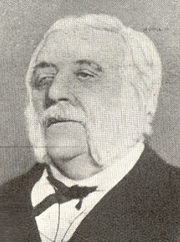
Alfred Bird was an English food manufacturer and chemist. He was born in Nympsfield, Gloucestershire, England in 1811 and was later a pupil at King Edward's School, Birmingham. He was the inventor of a series of food products, most notably egg-free custard and baking powder. His father was a lecturer in astronomy at Eton College. His son Alfred Frederick Bird continued to develop the business after his father's death.
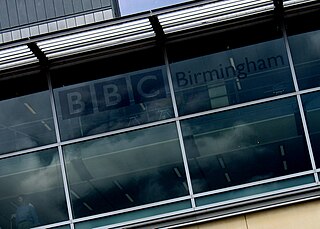
BBC Birmingham is one of the oldest regional arms of the BBC, located in Birmingham. It was the first region outside London to start broadcasting both the corporation's radio and television transmissions, the latter from the Sutton Coldfield television transmitter.

The Ikon Gallery is an English gallery of contemporary art, located in Brindleyplace, Birmingham. It is housed in the Grade II listed, neo-gothic former Oozells Street Board School, designed by John Henry Chamberlain in 1877.
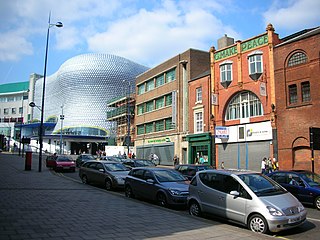
Digbeth is an area of central Birmingham, England. Following the destruction of the Inner Ring Road, Digbeth is now considered a district within Birmingham City Centre. As part of the Big City Plan, Digbeth is undergoing a large redevelopment scheme that will regenerate the old industrial buildings into apartments, retail premises, offices and arts facilities. The district is considered to be Birmingham's 'Creative Quarter'.

Castle Vale is a housing estate located between Erdington, Minworth and Castle Bromwich. Currently Castle Vale makes up the Castle Vale Ward of Birmingham City Council which is part of Erdington constituency, 6 miles (9 km) northeast of Birmingham city centre in England. The area has an approximate population of 10,000 people and has a distinctly modern residential character stemming from its history as a postwar overspill estate.

The Big City Plan is a major development plan for the city centre of Birmingham, England.

The Jewellery Quarter is an area of central Birmingham, England, in the north-western area of Birmingham City Centre, with a population of 19,000 in a 1.07-square-kilometre (264-acre) area.
Punch Records is a Birmingham-based music and arts agency. They offer tours, festivals, international projects and educational and outreach programs for young people.
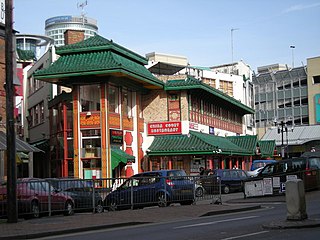
The Chinese Quarter of Birmingham, England is located in the city centre's Southside. It is an area with a predominantly Chinese influence as a result of a concentration of Chinese owned businesses, organisations and social clubs. The area now covers a neighbourhood that includes Hurst Street, Ladywell Walk and Pershore Street.

The O2 Institute (originally known as the Digbeth Institute) is a music venue located in Birmingham, England. The venue opened in 1908 as a mission of Carrs Lane Congregational Church. It has also served as an event centre, civic building and nightclub.

AIR is a 2,000 capacity superclub located in Digbeth, Birmingham in England. AIR started as a spray shop for buses, when in 2000 the building was bought by Godskitchen and converted into a club, originally named CODE. In June 2003, CODE closed for a complete refit and reopened in late September 2003 under the new name of AIR. Improvements included an extra room of music being added to the two already in use. Along with the club's name change, the 3 spaces inside were named the Oxygen Arena, the Nitrogen Room and the Carbon Lounge. The club features state-of-the-art lighting and sound systems. In 2002, Fergie said "It is one of the best [sound] systems I've ever played on, throughout the whole world".
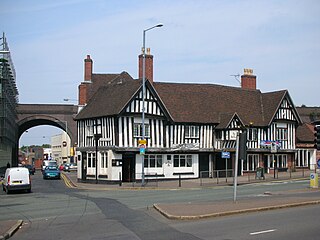
Deritend is a historic area of Birmingham, England, built around a crossing point of the River Rea. It is first mentioned in 1276. Today Deritend is usually considered to be part of Digbeth.

Eastside is a district of Birmingham City Centre, England that is undergoing a major redevelopment project. The overall cost when completed is expected to be £6–8 billion over ten years which will result in the creation of 12,000 jobs. 8,000 jobs are expected to be created during the construction period. It is part of the larger Big City Plan project.

The Warwick Bar conservation area is a conservation area in Birmingham, England which was home to many canalside factories during the Industrial Revolution of the eighteenth and nineteenth centuries.

Curzon Gate was a residential development located on the edge of Birmingham City Centre, West Midlands, England, on a prominent gateway site into the city centre. The land was formerly occupied by Castle Cement silos. The 4-acre (1.6 ha) site was located in the Eastside area, which is currently witnessing a large-scale regeneration scheme. It was located next to Curzon Park and opposite Eastside Locks, both of which are developments. It was bounded by a railway viaduct to the south and a road junction on the A4540 road. It was separated from Curzon Park by the Digbeth Branch Canal.

Eastside Locks is a major mixed-use development in the Eastside area of Birmingham, England. It is located next to the City Park development and opposite Curzon Gate. It is alongside the already completed Millennium Point and will cover the area to the rear of the building on top of the area alongside the road. It covers an area of 15.24 acres (6.17 ha). A replacement car park will be a multistorey building fronting Jennens Road.

Toin Adams, born in Kitwe, Zambia, is a sculptor working in steel, acrylic, fibreglass and other media. She spent her early childhood in eastern Rhodesia, and late teen years, in South Africa, where she attended the National School of the Arts, Johannesburg. In the late 80's she moved to England, where she began her career in sculpting.

Birmingham city centre, also known as Central Birmingham, is the central business district of Birmingham, England. The area was historically in Warwickshire. Following the removal of the Inner Ring Road, the city centre is now defined as being the area within the Middle Ring Road. The city centre is undergoing massive redevelopment with the Big City Plan, which means there are now nine emerging districts and the city centre is approximately five times bigger.